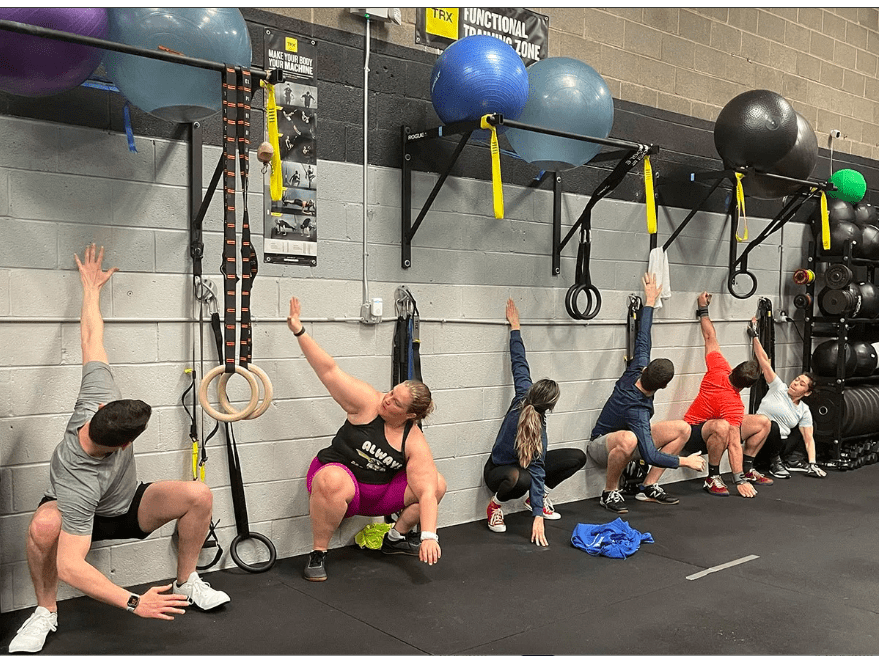Health
The Ultimate Guide to CrossFit Workouts: Boost Your Fitness Level

The Ultimate Guide to CrossFit Workouts: Boost Your Fitness Level
Before we dive into the specifics of CrossFit workouts, let’s first understand what CrossFit is all about. CrossFit is a high-intensity fitness program that combines elements of weightlifting, cardiovascular exercises, and bodyweight movements.
It is designed to improve overall fitness by targeting different aspects of physical performance, including strength, endurance, speed, agility, and flexibility.
One of the key principles of CrossFit is its emphasis on functional movements. Unlike traditional gym workouts that isolate specific muscle groups, CrossFit workouts are designed to mimic real-life movements and activities.
This means that the exercises you perform in a CrossFit workout are intended to help you become better at everyday tasks, such as lifting heavy objects, running, jumping, and climbing.
Another defining characteristic of CrossFit is its focus on intensity. CrossFit workouts are known for their high-intensity nature, pushing participants to their limits and challenging them both physically and mentally. This intensity is achieved through a combination of short, intense bursts of exercise, known as intervals, and minimal rest periods.
Now that we have a basic understanding of CrossFit, let’s explore the benefits of incorporating it into your fitness routine. One of the main advantages of CrossFit is its ability to improve overall fitness.
By targeting multiple aspects of physical performance, CrossFit workouts can help you build strength, increase endurance, enhance agility, and improve flexibility, all at the same time.
In addition to improving physical fitness, CrossFit can also have a positive impact on mental well-being. The intense nature of CrossFit workouts can release endorphins, which are natural mood boosters.
This can help reduce stress, improve mood, and increase overall happiness. Furthermore, the supportive and community-oriented nature of CrossFit can provide a sense of belonging and motivation, making it easier to stick to a regular exercise routine.
Now that you understand the benefits of CrossFit, how can you incorporate it into your fitness routine? The first step is to find a CrossFit gym or box near you. CrossFit workouts are typically done in a group setting, led by a certified CrossFit coach.
This not only ensures that you are performing the exercises correctly and safely but also provides an opportunity to learn from and be motivated by others.
Once you have found a CrossFit gym, it’s time to start attending classes. Most CrossFit gyms offer a variety of classes, ranging from beginner-friendly sessions to more advanced workouts. It’s important to start at a level that matches your current fitness level and gradually progress as you become more comfortable and confident.
CrossFit is not just a fitness program; it is a lifestyle.
It promotes a sense of community and camaraderie among its participants. In a CrossFit gym, or “box,” individuals of all fitness levels come together to support and motivate each other.
This supportive environment fosters a sense of belonging and helps individuals push past their limits. The workouts in CrossFit are constantly varied, meaning that no two workouts are the same.
This keeps participants engaged and prevents boredom.
Each workout, or “WOD” (Workout of the Day), is carefully designed to challenge different aspects of physical fitness. It may include a combination of weightlifting exercises like deadlifts and squats, cardiovascular exercises like running or rowing, and bodyweight movements like push-ups and pull-ups.
CrossFit workouts are intense and demanding, pushing participants to their limits.
However, they can be scaled and modified to accommodate individuals of all fitness levels. Whether you are a beginner or an elite athlete, CrossFit can be tailored to meet your specific needs and goals.
In addition to improving physical fitness, CrossFit also emphasizes the importance of nutrition. Many CrossFit athletes follow a paleo or primal-style diet, which focuses on consuming whole, unprocessed foods.
This approach to nutrition supports optimal performance and recovery.
CrossFit has gained popularity worldwide and has even become a competitive sport. The CrossFit Games, held annually, bring together the fittest athletes from around the globe to compete in a series of challenging workouts. These athletes showcase the incredible strength, endurance, and mental toughness that can be achieved through CrossFit training.
Overall, CrossFit is more than just a workout program.
It is a comprehensive approach to fitness that encompasses physical training, nutrition, and a supportive community. Whether you are looking to improve your overall fitness, lose weight, or compete at a high level, CrossFit offers a challenging and rewarding path to achieving your goals.
The Benefits of CrossFit
There are numerous benefits to incorporating CrossFit into your fitness routine.
Here are some of the key advantages:
- Improved Strength: CrossFit workouts are designed to challenge your muscles and promote strength gains. Through a combination of weightlifting and bodyweight exercises, you can build lean muscle mass and increase your overall strength.
- This increased strength can have a positive impact on your daily life, making tasks like carrying groceries or lifting heavy objects easier and more manageable.
- Enhanced Endurance: CrossFit workouts are intense and often involve high-intensity interval training (HIIT) components. This type of training can improve your cardiovascular fitness and boost your endurance levels.
- As a result, you’ll find yourself able to sustain physical activity for longer periods of time without feeling fatigued. Whether it’s running a marathon or simply keeping up with your kids, improved endurance can greatly enhance your overall quality of life.
- Increased Flexibility: Many CrossFit workouts incorporate stretching and mobility exercises, which can help improve your flexibility and range of motion. This increased flexibility can not only prevent injuries but also improve your performance in other physical activities.
- Whether you’re a yogi looking to deepen your poses or an athlete aiming to improve your agility, increased flexibility can be a game-changer.
- Weight Loss: CrossFit workouts are highly effective for burning calories and promoting weight loss. The combination of strength training and cardiovascular exercise can help you shed excess body fat and build a leaner physique.
- Additionally, the intensity of CrossFit workouts can lead to an increased metabolic rate, allowing you to continue burning calories even after your workout is over. This can help you achieve and maintain a healthy weight.
- Community and Support: CrossFit is known for its strong sense of community. When you join a CrossFit gym, you become part of a supportive network of individuals who are all working towards their fitness goals.
- This sense of community can provide motivation, accountability, and camaraderie. Whether it’s cheering each other on during a challenging workout or celebrating personal achievements, the CrossFit community can be a powerful source of support and encouragement.
In addition to these benefits, CrossFit also offers a variety of workout options to keep you engaged and motivated. With constantly varied workouts that combine elements of weightlifting, cardio, and gymnastics, you’ll never get bored.
The competitive nature of CrossFit can also push you to new limits and help you discover what you’re truly capable of. Whether you’re a beginner or an experienced athlete, CrossFit can be tailored to your fitness level, making it accessible to anyone willing to put in the effort.
It’s important to note that while CrossFit can be highly effective, it’s crucial to approach it with caution and proper form. Due to the intensity of the workouts, it’s recommended to work with a qualified CrossFit coach who can guide you through the exercises and ensure your safety. Additionally, listening to your body and allowing for proper rest and recovery is essential to prevent overtraining and injury.
In conclusion, incorporating CrossFit into your fitness routine can offer a wide range of benefits, including improved strength, enhanced endurance, increased flexibility, weight loss, and a supportive community.
With its varied workouts and competitive nature, CrossFit can help you reach your fitness goals and push you to new heights. So why not give it a try and see what it can do for you?
Getting Started with CrossFit
If you’re new to CrossFit, it’s important to start slowly and gradually increase the intensity of your workouts.
Here are some tips to help you get started:
- Find a Reputable CrossFit Gym: Look for a CrossFit gym in your area that has experienced coaches and a supportive community. They will be able to guide you through proper form and technique to prevent injuries.
- Focus on Technique: Before increasing the weight or intensity of your workouts, make sure you have mastered the proper form and technique for each exercise. This will help you prevent injuries and get the most out of your workouts.
- Listen to Your Body: Pay attention to how your body feels during and after workouts. If something doesn’t feel right or you’re experiencing pain, take a break and consult with a coach or healthcare professional.
- Set Realistic Goals: Set specific, achievable goals for yourself and track your progress. Whether it’s increasing your strength, improving your endurance, or losing weight, having clear goals will help keep you motivated and focused.
- Stay Consistent: Consistency is key when it comes to seeing results with CrossFit. Aim for regular workouts and make it a part of your weekly routine.
- Gradually Increase Intensity: As you become more comfortable with the exercises and your fitness level improves, gradually increase the intensity of your workouts. This can be done by adding more weight, increasing the number of repetitions, or shortening your rest periods.
- Include Rest Days: Rest days are just as important as workout days. Give your body time to recover and repair itself by scheduling regular rest days in your training program. This will help prevent overtraining and reduce the risk of injury.
- Stay Hydrated and Fuel Your Body: Proper hydration and nutrition are essential for optimal performance and recovery. Make sure to drink plenty of water before, during, and after your workouts, and fuel your body with nutritious foods to support your training.
- Join the Community: CrossFit is known for its strong community spirit. Get involved and connect with other CrossFitters at your gym or through online forums and social media. Surrounding yourself with like-minded individuals can provide motivation, support, and accountability.
- Track Your Progress: Keep a record of your workouts, including the exercises, weights, and times. This will allow you to track your progress over time and see how far you’ve come. It can also help you identify areas for improvement and set new goals.
By following these tips, you’ll be well on your way to getting started with CrossFit and embarking on a journey toward improved fitness and overall well-being. Remember to always listen to your body, work at your own pace, and enjoy the process of challenging yourself and reaching new heights.
Sample CrossFit Workout
Here’s a sample CrossFit workout to give you an idea of what to expect:
Warm-up:
- 5 minutes of light cardio (e.g., jogging, cycling)
- Dynamic stretches for major muscle groups
Workout:
- 5 rounds of the following:
- 10 kettlebell swings
- 15 box jumps
- 20 push-ups
- Rest for 2 minutes between rounds
Cool-down:
- 5-10 minutes of light cardio
- Static stretches for major muscle groups
Remember to always consult with a healthcare professional before starting any new exercise program, especially if you have any pre-existing medical conditions or injuries.
CrossFit is a high-intensity fitness program that combines elements of weightlifting, cardio, and bodyweight exercises. It is known for its constantly varied workouts that challenge participants both mentally and physically.
The sample workout provided above is just one example of the many different workouts you may encounter in a CrossFit class. The warm-up portion of the workout is essential to prepare your body for the intense exercises that lie ahead.
By starting with light cardio, such as jogging or cycling, you increase your heart rate and warm up your muscles. Dynamic stretches, which involve moving parts of your body through a full range of motion, help to improve flexibility and prevent injuries.
The main workout consists of five rounds of kettlebell swings, box jumps, and push-ups. Kettlebell swings are a full-body exercise that targets your legs, glutes, and core. Box jumps are a plyometric exercise that works your lower body and improves explosive power.
Push-ups are a classic exercise that targets your chest, shoulders, and triceps. By performing these exercises in a circuit format, you challenge your cardiovascular system and build strength and endurance.
It is important to note that rest is an integral part of the workout.
Taking a 2-minute break between rounds allows your body to recover and maintain proper form throughout the workout. This rest period also helps to prevent overexertion and reduce the risk of injury.
After completing the main workout, the cool-down phase is crucial for gradually bringing your heart rate and breathing back to normal.
Light cardio exercises, such as walking or cycling, help to flush out any lactic acid build-up in your muscles and promote recovery. Static stretches, where you hold a stretch without movement, are performed to improve flexibility and reduce muscle soreness.
While this sample CrossFit workout provides a general framework, it is important to remember that CrossFit is highly customizable to individual fitness levels and goals.
In a CrossFit class, workouts are often scaled or modified to accommodate participants of all abilities. Whether you are a beginner or an experienced athlete, CrossFit can provide a challenging and rewarding fitness experience.
8. What are the benefits of CrossFit?
CrossFit offers a wide range of benefits for individuals of all fitness levels.
Some of the key benefits include:
- Improved Strength and Endurance: CrossFit workouts incorporate a variety of functional movements and exercises that target different muscle groups. This helps to build overall strength and endurance, allowing you to perform daily activities more efficiently.
- Increased Cardiovascular Fitness: The combination of high-intensity interval training (HIIT) and cardiovascular exercises in CrossFit workouts helps to improve your heart health and increase your aerobic capacity.
- Weight Loss and Body Composition: CrossFit workouts are designed to burn calories and promote fat loss. The combination of strength training and cardio exercises helps to build lean muscle mass and boost your metabolism, leading to improved body composition.
- Functional Fitness: CrossFit focuses on functional movements that mimic real-life activities, such as lifting, pushing, pulling, and squatting. This helps to improve your overall physical performance and make daily tasks easier.
- Community and Support: CrossFit is known for its strong sense of community and support. Working out in a group setting can provide motivation, accountability, and a sense of camaraderie.
- Mental Toughness: CrossFit workouts are challenging both physically and mentally. Pushing yourself to overcome obstacles and complete difficult workouts can help to build mental resilience and improve your mindset.
Overall, CrossFit offers a comprehensive approach to fitness, combining strength training, cardiovascular exercise, and functional movements to help you achieve your health and fitness goals.
In conclusion,
CrossFit is a highly effective and efficient way to improve overall fitness. By incorporating elements of weightlifting, cardiovascular exercises, and bodyweight movements, CrossFit workouts target multiple aspects of physical performance, helping you become stronger, fitter, and more agile. Whether you are a beginner or an experienced athlete, CrossFit can provide the challenge and motivation you need to take your fitness to the next level.
Health
6 Daily Habits to Naturally Lower Cholesterol Levels
Health
Understanding the Rapid Spread of Monkeypox’s New Strain Clade 1b

Understanding the Rapid Spread of Monkeypox’s New Strain Clade 1b: Key Facts on Transmission, Symptoms, Severity, and Vaccination
Monkeypox, a viral disease with symptoms resembling smallpox, has recently gained attention due to the emergence of a newstrain, Clade 1b.
This article delves into the essential details about this new variant, including how it spreads, its symptoms, its severity, and the current state of vaccinations.
Our goal is to provide a comprehensive and clear understanding of this evolving situation, enabling readers to stay informed and prepared.
Monkeypox, once a rare and somewhat obscure disease, has recently become a significant public health concern due to the emergence of new strains.
Among these, Clade 1b has been noted for its rapid spread and distinct characteristics.
As we navigate through the complexities of this variant, it is crucial to grasp the fundamentals of its transmission, symptoms, severity, and preventive measures, including vaccination.
Understanding Monkeypox Clade 1b
What is Monkeypox?
Monkeypox is a zoonotic virus belonging to the Orthopoxvirus genus, which also includes smallpox.
First identified in monkeys, it can infect humans through close contact with infected animals or individuals.
While it shares similarities with smallpox, monkeypox tends to be less severe and less transmissible.
Clade 1b Overview
Monkeypox has several clades (strains), with Clade 1b being the most recent and notable for its rapid spread.
This strain has shown increased transmissibility compared to previous clades, raising concerns among public health officials.
Transmission of Clade 1b
Modes of Transmission
Clade 1b spreads primarily through:
- Direct Contact: Contact with bodily fluids, skin lesions, or contaminated surfaces of an infected person.
- Respiratory Droplets: Prolonged face-to-face interaction can lead to transmission through respiratory droplets.
- Animal Contact: Infected animals, particularly rodents and primates, can transmit the virus to humans.
Environmental Factors
Transmission rates can also be influenced by environmental factors such as:
- Crowded Living Conditions: Higher transmission rates are observed in densely populated areas.
- Sanitation Practices: Poor hygiene and sanitation can facilitate the spread of the virus.
Symptoms of Monkeypox Clade 1b
Early Symptoms
The symptoms of Clade 1b may resemble those of other viral infections, making initial diagnosis challenging.
Early symptoms include:
- Fever: A sudden onset of high temperature.
- Headache: Severe headaches that can persist for days.
- Muscle Aches: Generalized muscle pain and discomfort.
- Fatigue: Extreme tiredness and weakness.
Rash and Skin Lesions
A defining feature of monkeypox is the rash, which typically progresses through several stages:
- Macules: Flat, discolored spots on the skin.
- Papules: Raised bumps.
- Vesicles: Fluid-filled blisters.
- Pustules: Pus-filled lesions that eventually crust over.
Severe Symptoms
In more severe cases, symptoms may include:
- Encephalitis: Inflammation of the brain, leading to neurological symptoms.
- Pneumonia: Infection of the lungs that can cause difficulty breathing.
- Secondary Infections: Bacterial infections that may complicate the healing process.
Severity of Clade 1b
General Outlook
Clade 1b has been associated with a higher transmission rate and more severe outcomes compared to other strains. However, the overall severity can vary widely among individuals.
Factors influencing severity include:
- Immune System Status: Individuals with weakened immune systems or pre-existing conditions may experience more severe symptoms.
- Age: Young children and elderly individuals are at higher risk of severe illness.
- Timeliness of Medical Care: Early medical intervention can significantly affect the outcome.
Mortality Rates
The mortality rate for Clade 1b is currently under study, but initial data suggest it may be higher than previous strains. Prompt medical attention and supportive care are crucial in reducing the risk of severe outcomes.
Vaccination and Prevention
Current Vaccines
Vaccination is a key strategy in controlling the spread of monkeypox.
The following vaccines are relevant:
- Smallpox Vaccine: The smallpox vaccine is effective against monkeypox due to the similarities between the viruses. It provides protection for those who have been recently vaccinated or who received it in the past.
- Monkeypox-Specific Vaccine: Research is ongoing into vaccines specifically targeting monkeypox, with several candidates showing promise in trials.
Vaccination Recommendations
Public health authorities recommend vaccination for:
- Healthcare Workers: Individuals who are at higher risk due to their profession.
- High-Risk Populations: People in areas experiencing outbreaks or those with frequent exposure to infected individuals.
Preventive Measures
In addition to vaccination, preventive measures include:
- Good Hygiene: Regular handwashing and use of hand sanitizers.
- Avoiding Contact: Minimizing close contact with individuals displaying symptoms or with infected animals.
- Isolation: Infected individuals should isolate themselves to prevent the spread of the virus.
Conclusion
The emergence of Monkeypox Clade 1b represents a significant challenge to global health. Its increased transmissibility and potential for severe outcomes highlight the importance of staying informed and proactive.
By understanding its transmission, symptoms, and preventive measures, individuals and communities can better protect themselves and mitigate the impact of this new strain.
FAQs
1. What makes Clade 1b different from other monkeypox strains?
Clade 1b is noted for its increased transmissibility and potentially more severe outcomes compared to other strains.
It spreads faster and may lead to more serious health issues, necessitating closer monitoring and enhanced preventive measures.
2. How can I tell if I have monkeypox or another viral infection?
Monkeypox often begins with flu-like symptoms and progresses to a distinct rash.
If you experience these symptoms, especially if you’ve been in contact with someone who has monkeypox or are in an outbreak area, seek medical advice for accurate diagnosis and testing.
3. Is the smallpox vaccine effective against Monkeypox Clade 1b?
Yes, the smallpox vaccine offers protection against monkeypox, including Clade 1b, due to the similarities between the two viruses.
However, its effectiveness may vary based on factors such as time since vaccination and individual health conditions.
4. Are there any new vaccines specifically for monkeypox?
Research is ongoing to develop and approve vaccines specifically targeting monkeypox.
Several candidates are in various stages of clinical trials, with some showing promising results in enhancing protection against monkeypox strains, including Clade 1b.
5. What should I do if I suspect I have monkeypox?
If you suspect you have monkeypox, contact a healthcare provider immediately. They can guide you through testing, diagnosis, and appropriate care.
In the meantime, practice good hygiene and avoid close contact with others to prevent spreading the virus.
References:
Health
Understanding the Low Risk of Mpox Outbreak in India and Our Preparedness Measures

-

 Trending Stories1 year ago
Trending Stories1 year agoCDC: 1 in 4 Americans Still COVID-Free by End of 2022
-

 Health5 years ago
Health5 years agoMeghan Trainor Shares Motivational New Song ‘Blink’
-

 Health2 years ago
Health2 years agoHow Long Does Monkey Pox Last Before It Surfaces in the Body?
-

 Health2 years ago
Health2 years agoWhat Causes Swollen Body? Understanding Edema and its Triggers
-

 Health4 months ago
Health4 months agoHow Do Pawpaw Seeds Support Cardiovascular Health?
-

 Health3 years ago
Health3 years agoNutrition and the Importance of a Fitness Program – 3 Things to Know
-

 Health3 years ago
Health3 years ago5 Weird Reasons Why Pimples Disappear After Marriage
-

 Health2 years ago
Health2 years agoHealth Benefits Of Pawpaw Seed? 7 Things To Know







